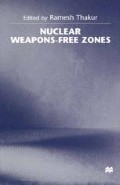Abstract
The 1990s are witnessing a restructuring of the global strategic order, reflecting the realities of the emerging post-Cold War world — an environment that is not necessarily more peaceful, but where major wars between leading nations are less likely than they have been for the last fifty years. The strategic order is in transition, from a bipolar, through temporary unipolarity, to a multipolar world. Yet major powers will still have a dominant voice for some time. A major impact of this has been on the state of weapons of mass destruction (WMD). It had been hoped that after the Cold War, a serious debate would emerge on the role of WMD, and that these could be eliminated over a period of time through international consensus. But the reality has unfolded differently. The nuclear-weapons states (NWS) continue to see these weapons as necessary for their security. Given their ultimate global political authority as permanent members of the UN Security Council, their views are likely to prevail, as long as there is consensus amongst them.
Access this chapter
Tax calculation will be finalised at checkout
Purchases are for personal use only
Preview
Unable to display preview. Download preview PDF.
Notes
Mike Moore, ‘End the Nuclear Disarmament Shell Game’, Disarmament Diplomacy 9 (October 1996), pp. 5–6.
Michael Hamel-Green, ‘Nuclear Weapon Free Zone: Peeling the Nuclear Orange from the Bottom Up’, Disarmament Diplomacy 9 (October 1996), pp. 7–10.
Zachary S. Davis, ‘The Spread of Nuclear-Weapon-Free Zones: Building a New Nuclear Bargain’, Arms Control Today 26 (February 1996), p. 15.
Mahmoud Karem, A Nuclear-Weapon-Free Zone in the Middle East: Problems and Prospects (New York: Greenwood, 1988), pp. 53–5.
Editor information
Editors and Affiliations
Copyright information
© 1998 Palgrave Macmillan, a division of Macmillan Publishers Limited
About this chapter
Cite this chapter
Banerjee, D. (1998). The Obstacles to a South Asian Nuclear-Weapon-Free Zone. In: Thakur, R. (eds) Nuclear Weapons-Free Zones. Palgrave Macmillan, London. https://doi.org/10.1007/978-1-349-26972-3_9
Download citation
DOI: https://doi.org/10.1007/978-1-349-26972-3_9
Publisher Name: Palgrave Macmillan, London
Print ISBN: 978-1-349-26974-7
Online ISBN: 978-1-349-26972-3
eBook Packages: Palgrave Political & Intern. Studies CollectionPolitical Science and International Studies (R0)

